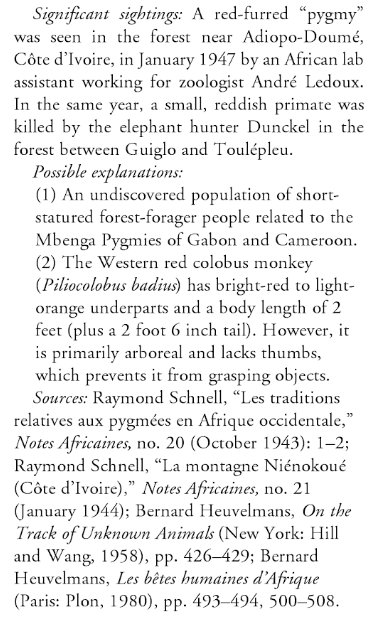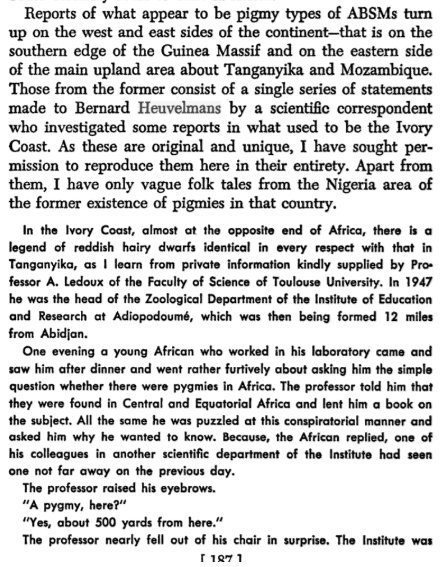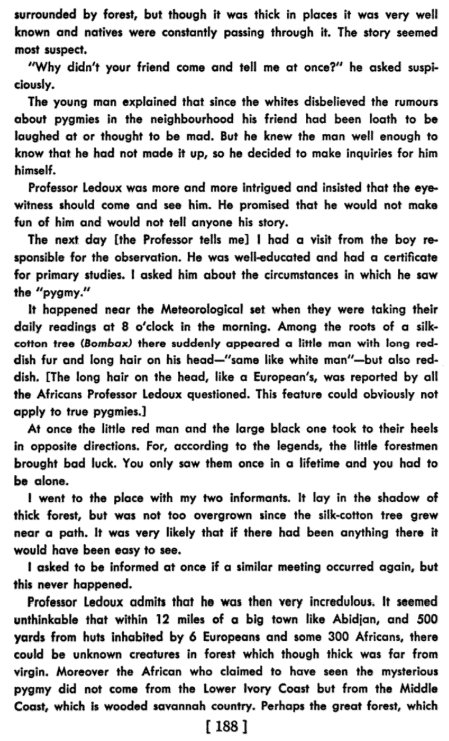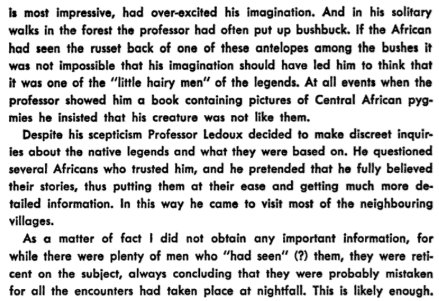Bernard Heuvelmans (1916 - 2001), the Belgian-French scientist who can be considerd to be the father of cryptozoology, reported in on of his books circa 1959 or 1962, on a story recorded for him by Professor André Ledoux of the Faculty of Science of Toulouse University. In 1947, Ledoux he was the head of the Zoological Department of the lnstitute of Education and Research ("IDERT") at Adiopodoume, near Abidjan, Ivory Coast, Africa.
In 1947, Ledoux interrogated a boy who said to have witnessed a weird "pigmy" the day before. Ledoux said the boy was well-educated and had a certificate for primary studies.
The boy said that near the Meteorological set when they were taking their daily readings at 8 a.m., among the roots of a silk~ cotton tree (Bombox), suddenly appeared a little man with long reddish fur, and long hair on his head "same like white man" but also reddish.
At once, the little red man and the tall black boy took to their heels in opposite directions: according to the legends, the little forest men brought bad luck.
Ledoux went to the place with the witness, and noted it lay in the shadow of thick forest, but was not too overgrown since the silk-cotton tree grew near a path. It was very likely that if there had been anything there it would have been easy to see.
Ledoux showed the boy pictures of Central African pygmies, and the boy insisted that his creature was not like them.
Ledoux asked to be informed at once if a similar meeting occurred again, but thls never happened.
Ledoux told he was very incredulous, as it seemed unthinkable that within 12 miles of a big town like Abidjan, and 500 yards from huts inhabited by 6 Europeans and some 300 Africans, there could be unknown creatures in forest which though thick was far from virgin. Moreover the African who claimed to have seen the mysterious pygmy did not come from the Lower Ivory Coast but from the Middle Coast, which is wooded savannah country, so he was not used to what could be seen in such location.
Ledoux suggested the witness may have seen the russet back of an antelopes among the bushes, and his imagination led him to think that it was one of the "little hairy men" of the legends.
Decades later, two "skeptical" ufologists included a two-sentence summary of all this, without mentioning Ledoux's skepticism and proposed explanation.
|
|
[Ref. ge1:] GEORGE M. EBERHART:

|
|
Significant sightings: A red-furred "pygmy" was seen in the forest near Adiopo-Doume, Cote d'Ivoire, in January 1947 by an African lab assistant working for zoologist Andre Ledoux. In the same year, a small, reddish primate was killed by the elephant hunter Dunckel in the forest between Guiglo and Toulepleu. Possible explanations: (1) An undiscovered population of short-statured forest-forager people related to the Mbenga Pygmies of Gabon and Cameroon. (2) The Western red colobus monkey (Piliocolobus badius) has bright-red to light-orange underparts and a body length of 2 feet (plus a 2 foot 6 inch tail). However, it is primarily arboreal and lacks thumbs, which prevents it from grasping objects. Sources: Raymond Schnell, "Les traditions relatives aux pygmees en Afrique occidentale," Notes Africaines, 110. 20 (October 1943): 1-2; Raymond Schnell, "La Montagne Nienokoue (Cote d'Ivoire)," Notes Africaines, no. 21 (January 1944); Bernard Heuvelmans, On the Track of Unknown Animals (New York: Hill and Wang, 1958), pp. 426-429; Bernard Heuvelmans, Les betes humaines d'Afrique (Paris: Plon, 1980), pp. 493-494, 500-508. |
[Ref. is1:] IVAN T. SANDERSON:

|
|
[...] Reports of what appear to be pigmy types of ABSMs turn up on the west and east sides of the continent-that is on the southern edge of the Guinea Massif and on the eastern side of the main upland area about Tanganyika and Mozambique. Those from the former consist of a single series of statements made to Bernard Heuvelmans by a scientific correspondent who investigated some reports in what used to be the Ivory Coast. As these are original and unique, I have sought permission to reproduce them here in their entirety. Apart from them, I have only vague folk tales from the Nigeria area of the former existence of pigmies in that country. In the Ivory Coast, almost at the opposite end of Africa, there Is a legend of reddish hairy dwarfs identical in every respect with that ln Tanganyika, as I learn from private information kindly supplied by Professor A. Ledoux of the Faculty of Science of Toulouse University. In 1947 he was the head of the Zoological Department of the lnstitute of Education and Research at Adiopodoume, which was then being formed 12 miles from Abidjan. One evening a young African who worked in his laboratory come and saw him after dinner and went rather furtively about asking him the simple question whether there were pygmies in Africa. The professor told him that they were found in Central and Equatorial Africa and lent him a book on the subject. All the same he was puzzled at this conspiratorial manner and asked him why he wanted to know. Because, the African replied, one of his colleagues in another scientific department of the Institute had seen one not far away on the previous day. The professor raised his eyebrows. "A pygmy, here?" "Yes, about 500 yards from here." The professor nearly fell out of his chair in surprise. The Institute was 187 |

|
|
surrounded by forest, but though it was thick in places it was very well known and natives were constantly passing through It. The story seemed most suspect. "Why didn't your friend come and tell me at once?" he asked suspiciously. The young man explained that since the whites disbelieved the rumours about pygmies in the neighbourhood his friend had been loath to be laughed at or thought to be mad. But he knew the man well enough to know that he had not made it up, so he decided to make inquiries for him himself. Professor Ledoux was more and more intrigued and insisted that the eyewitness should come and see him. He promised that he would not make fun of him and would not tell anyone his story. The next day (the Professor tells me) I had a visit from the boy responsible for the observation. He was well-educated and had a certificate for primary studies. I asked him about the circumstances in which he saw the "pygmy." It happened near the Meteorological set when they were taking their dally readings at 8 o'clock in the morning. Among the roots of a silk~ cotton tree (Bombox) there suddenly appeared a little man with long reddish fur and long hair on his head - "same like white man" - but also reddish. (The long hair on the head, like a European's, was reported by all the Africans Professor Ledoux questioned. This feature could obviously not apply to true pygmies.) At once the litle red man and the large black one took to their heels in opposite directions. For, according to the legends, the little forest men brought bad luck. You only saw them once in a lifetime and you had to be alone. I went to the place with my two informants. It lay in the shadow of thick forest, but was not too overgrown since the silk-cotton tree grew near a path. It was very likely that if there had been anything there it would have been easy to see. I asked to be informed at once if a similar meeting occurred again, but thls never happened. Professor Ledoux admits that he was then very incredulous. It seemed unthinkable that within 12 miles of a big town like Abidjan, and 500 yards from huts inhabited by 6 Europeans and some 300 Africans, there could be unknown creatures in forest which though thick was far from virgin. Moreover the African who claimed to have seen t.he mysterious pygmy did not come from the Lower Ivory Coast but from the Middle Coast, which Is wooded savannah country. Perhaps the great forest, which 188 |

|
|
is most impressive, had over-excited his imagination. And in his solitary walks in the forest the professor had often put up bushbuck. If the African had seen the russet back of ene of these antelopes among the bushes it was not impossible that his imagination should have led him to think that it was one of the "little hairy men" of the legends. At all events when the professor showed him a book containing pictures of Central African pygmies he insisted that his creature was not like them. Despite his scepticism Professor Ledoux decided to make discreet inquiries about the native legends and what they were based on. He questioned several Africans who trusted him, and he pretended that he fully believed their stories, thus putting them at their ease and getting much more detailed Information. In this way he came to visit most of the neighbouring villages. As a matter of fad I did not obtain any important information, for while there were plenty of men who "had seen" (?) them, they were reticent on the subject, always concluding that they were probably mistaken for all the encounters had taken place at nightfall. This is likely enough. [...] |
[Ref. go1:] GODELIEVE VAN OVERMEIRE:
|
1947. IVORY COAST, Adiopodoumé A young African living near the Institute of Education and Research, located near the forest, saw a small man with red fur on his body and long hair on his head. This creature came out of the trees, but finding that it was not alone, it retreated into the forest. (Janet and Colin BORD: "Modern Mysteries of the World" - Guild Publishing London 1989, p. 198) |
[Ref. pr1:] PETER ROGERSON:
|
1947. 0800hrs. ABIJAN (ABIJAN : IVORY COAST) A worker taking a meterological reading at the Adiopodoume Botanical Garden about 19km from the town centre suddenly encountered a dwarf with red fur and dark hair. Both man and creature ran off in opposite directions. Heuvelmans 1962 p426 |
[eb1] says the witness worked for Pr. Ledoux; but he worked for the local weather men team.
Janet and Colin Bord, cited by [go1] as the source, are British authors of numerous "mystery" books compiling all sorts of alleged creature, ghosts, fairies, pixies sightings from all over the world. It certainly provides many reports, but there is no search for any case-by-case explanation, and no effort at sorting out different kinds of reports.
Bernard Heuvelmans (1916 - 2001), cited in [pr1] as the source, was a Belgian-French scientist, explorer, and author. He was the founder of what became known as cryptozoology, the search for previously unknown animals. His work of course had nothing to do with UFOs or aliens.
Bibliographies of Heuvelmans do not list a book for 1962. The [pr1] reference to "Heuvelmans 1962 p426" is likely rather some reissue of "On the Track of Unknown Animals", by Heuvelmans, published in 1959.
Now, about this "case", there is so much to say...
To be fair, Rogerson [pr1] did explain why he included such stories in his INTCAT catalogue: it was to show that inventions and imagination always existed, resulting in fairy, ghost, weird animal reports, all mistakes or hoaxes, so that UFO occupants sighting reports must be of the same kind.
In this case, there is no bulletproof prosaic explanation, but one can share Pr. Ledoux's consideration on the possible misinterpretations of ordinary animals poorly seen in the dark. Whatever this explanation is worth, obviously, this has nothing to do intrinsically with UFOs and their occupants.
An alternate explanation would be a red colobus monkey (see here).
On a side note: some cryptozoologists are suggesting that the little red men of the area, called "Agogwe" by the locals, would be humans of the ancient Australopithecus species.
| Id: | Topic: | Severity: | Date noted: | Raised by: | Noted by: | Description: | Proposal: | Status: |
|---|---|---|---|---|---|---|---|---|
| - | ||||||||
Possible antelope or colobus, not UFO-related.
* = Source I checked.
? = Source I am told about but could not check yet. Help appreciated.
| Main Author: | Patrick Gross |
|---|---|
| Contributors: | None |
| Reviewers: | None |
| Editor: | Patrick Gross |
| Version: | Created/Changed By: | Date: | Change Description: |
|---|---|---|---|
| 0.1 | Patrick Gross | October 12, 2018 | Creation, [ge1], [ia1], [ov1], [pr1]. |
| 1.0 | Patrick Gross | October 12, 2018 | First published. |